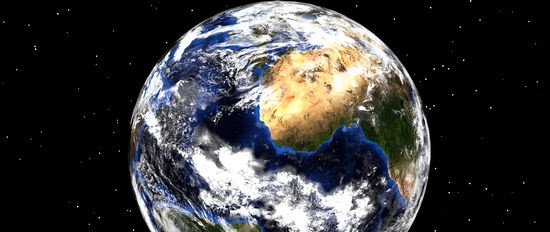Strength of the Earth |
|
Indeed, what would become of the Earth if it turned into a liquid? Knowing from everyday experience that solids lose their shape when melted, we might expect the same to happen to the Earth. But in reality this will not happen. In those objects with which we are dealing in practical life, the ability to maintain shape is due to the forces acting between close atoms. But such "Heavy" bodies, like the Earth, the gravitational force also begins to play an essential role, with which the entire mass of the Earth attracts each of its particles. It would have ensured, in the main, the preservation of the present shape of the Earth, even if our planet had become a liquid body. Consequently, when calculating the deformations of the Earth and assessing its strength as a whole (and not individual samples of rocks), it is necessary to take into account both the elastic properties of the Earth's substance and the effect of gravity on it. The laboratories study the mechanical properties of rocks taken from the outer layer of the Earth only a few kilometers thick. This layer affects the strength of the Earth as a whole a little more than a thin layer of paint applied to its surface affects the strength of a metal ball. Information about the deeper layers of the Earth is provided to us mainly by the study of the propagation of seismic waves. It is not without reason that Academician B. B. Golitsyn called the earthquake a lantern, which, flashing for a moment, allows us to see the interior of the Earth. But, developing this comparison, we must say that the light of such a lantern dims at a depth of 2,900 km from the Earth's surface. Below is the core of the Earth, through which only longitudinal seismic waves pass. So, in order to estimate the strength of the Earth as a whole, it is necessary to consider the problem of deformations and stresses of a gravitating ball, consisting of an inhomogeneous elastic shell and a core. How the density and elastic properties of the shell change with depth can be considered known. With regard to the core, one has to start with hypotheses. Thus, it is natural to assume that the core, possibly with the exception of its central part, is in a liquid state, since transverse seismic waves do not pass through it. (Note that the hypothesis of the Earth's liquid core was considered even before the emergence of seismology. But then it was refuted, because it was believed that the Earth's shell was only a few kilometers or tens of kilometers thick, and such a shell with a liquid core, as W. Thomson showed, was would be shattered by the tide in the core.)
Tidal forces are constantly acting on the Earth, stretching it along straight lines connecting the center of the Earth with the centers of the Moon and the Sun. The Earth's surface sags under the load of air masses in areas with high atmospheric pressure. All particles of the Earth are acted upon by a centrifugal force directed perpendicular to the axis of rotation of the Earth.It is clear that the direction of this force will change if the position of the axis of rotation in the Earth's body changes. And the fact that this is really happening was established at the end of the last century. The magnitudes and directions of the above forces can be calculated. If we then take any model of the Earth, then we can theoretically also find the deformation of the Earth when these forces are applied to it, for example, calculate how the distances of various points on the earth's surface from its center will change. Take, for example, the tidal force, which, as has been said, stretches the Earth along a straight line connecting its center O with the center L of the disturbing body: the Moon or the Sun. Under its influence, the Earth's surface, if it were a regular sphere of radius R, would take the form of an ellipsoid of revolution with the semi-major axis a directed to L. Let us assume that we managed to calculate what the difference a - R is equal to for this model. Then we can find the change in length the radius of the vector p of any point on the earth's surface. These changes are small. For none of the theoretically considered models of the Earth, the maximum fluctuations in length p under the joint influence of the Moon and the Sun do not reach one meter. It is clear that such changes cannot be measured directly. Why did we have to invent a "weightless" ocean? Yes, because the tide in the real ocean somewhat complicates the phenomenon: it leads to changes in the gravitational potential of the Earth itself. The elastic deformations of the Earth give a similar effect. The ratio of the change in the gravitational potential of the Earth to the external potential, this change causing it, is designated by the symbol k. The parameters h and k are called Love numbers, after the English geophysicist who first introduced these parameters to characterize the mechanical properties of the Earth as a whole. It is these parameters that are calculated theoretically for different models of the Earth; they try to determine them from the analysis of observations of various phenomena. What are these phenomena? Let's list the most important of them:
This is the case with absolutely solid Earth. But if we take into account that under the influence of various forces the Earth is deformed, the picture will be more complicated. The tidal forces deform the Earth so that its compression changes somewhat all the time. This means that in our model the mass of the ring will change, and this, in turn, will manifest itself in weak periodic fluctuations in the angular velocity of the Earth's rotation. When its compression decreases, the speed increases and the Earth begins to overtake evenly This is one side of the issue. But the deformations of the Earth affect its rotation in another way. To explain exactly how, let's make the following mental experience. Let's imagine that the Earth's rotation has stopped and the centrifugal force no longer acts on it. Moreover, if the Earth were an absolutely solid body, its shape would remain the same. If the Earth were a liquid body, it would take the shape of a regular ball. The equatorial excess of masses, and with it the ring in our model, would then disappear altogether. But on the real Earth, when its rotation stops, internal elastic forces will come into play. They will oppose gravitational forces, and thanks to this, the Earth will still remain a compressed spheroid, although its compression will decrease. This means that the mass of the ring of our model will also decrease. How much? This is the main question, on the solution of which the assessment of the hardness of the Earth depends. We noted that the period of free nutation is shorter, the greater the equatorial excess of masses, that is, the mass of the ring. For an absolutely solid Earth, this period would be equal to 305 days. In reality, as the analysis of data on the motion of the Earth's poles over the past 70 years shows, it is close to 430 days. This was explained by the fact that the period of free nutation depends not on the entire equatorial excess of masses, but only on that part of it that would not disappear if the action of the centrifugal force ceased. Hence, it is easy to calculate that the cessation of rotation reduces the mass of the ring of our model by 30%. (More precisely, this ring is divided into two, and one of them, containing about a third of the total mass, is always installed in a plane perpendicular to the instantaneous axis of rotation, and does not affect the motion of this axis in the Earth's body.) The above number shows at which conditions, there would be a balance between gravitational forces striving to turn the Earth into a ball, and elastic forces striving to keep its shape unchanged. In the course of these works, some conclusions of the theory of rotation of the Earth with a liquid core were refined. Thus, it turned out that the influence of the liquid core should lead to changes in the amplitudes of some oscillations of the earth's axis in space (forced nutation). It also manifests itself in the fact that one more weak circular motion with a period close to days is added to the already known components of the motion of the Earth's poles. Finding these effects is a challenge that lies at the limit of the capabilities of modern astronomy. But it was worth trying. Such an attempt was made by Ukrainian astronomers. It turned out to be successful. In particular, N.A. Popov succeeded in detecting, in long-term observations of two zenith stars in Poltava, weak fluctuations in latitude with a period predicted by M.S.Modensky's theory. Thus, new arguments were obtained in favor of the hypothesis of the Earth's liquid core. Now we can say that the Earth as a whole appears to be stronger than a hollow steel ball with a shell about 3 thousand km thick. However, the following can be objected to such an assessment. All our conclusions were drawn from the study of very weak deformations. Can we use them if we have to calculate the actions of forces that cause much more significant deformations and even threaten the integrity of our planet? Apparently, it is impossible without significant adjustments.But is there a threat of the emergence of such powerful forces that such calculations will become necessary? Will this not happen, say, because the rotation regime of our planet will be significantly disrupted? Natural reasons for this are difficult to find. However, over time, will people not be able to change the rotation of the Earth at their own discretion? This is not the first time this question has been asked.
However, the matter ended in nothing. It turned out that in their calculations, the engineers of the Arctic Company made a gross mistake: they did not take into account the fact that the Earth is not a ball, but has an additional mass in the equatorial belt. Taking this mass into account, one French engineer made new calculations and showed that under the action of the projected shot, the poles of the Earth would move on its surface by only 3 microns. Curious that this story, as told in the book "Rotation of the Earth" American geophysicists Munk and MacDonald, has a modern continuation. In. During the presidential elections in 1956, Senator Estes Kefauver, the candidate for the post of vice-president, said that as a result of tests of hydrogen bombs, the Earth's axis could deviate by 10 °. However, accurate calculations show otherwise. The energy released by the explosion of a medium-power hydrogen bomb would be enough to give a projectile weighing a million tons a speed of 11 kilometers per second. But the recoil of a cannon that would have fired such a shot would have displaced the Earth's pole by just one micron. “And 70 years after Jules Verne,- note the authors, - members of the Washington government still refuse to acknowledge the existence and significance of the equatorial excess of the masses "... Consequently, even the super-powerful means that people now possess are insufficient to have any appreciable effect on the rotation of the Earth. So, our planet is solid and durable enough to withstand forces acting periodically or for a short time: they only subtly deform it. But the effect may be different if the forces act in the same direction for millions of years. Probably, in relation to such forces, the Earth behaves not as an ideally elastic body, but as a plastic body that changes its shape, albeit slowly, but significantly. Here we come to the issues of the evolution of the Earth and the role that internal processes play in this. They create stresses in the earth's body, sometimes exceeding its ultimate strength. It is possible that at the same time tidal deformations of the Earth and even slight disturbances in the constancy of its rotation sometimes play the role of a "trigger", that is, that last shock that causes ruptures and shifts in the Earth's crust and mantle. The latter phenomena, in turn, can influence the rotation of the Earth, and geophysicists and astronomers are now actively looking for manifestations of this influence. E. Fedorov |
| What is a cage? | Physiological two-dimensionality of information: mechanisms and consequences |
|---|
New recipes
 "Oh, if this too, too heavy body melted, dissolved, became dew!" The famous English geophysicist Harold Jeffries took these words of Hamlet as an epigraph to one of the chapters of his book "Earth".
"Oh, if this too, too heavy body melted, dissolved, became dew!" The famous English geophysicist Harold Jeffries took these words of Hamlet as an epigraph to one of the chapters of his book "Earth". To test hypotheses about the properties of the nucleus, it is natural to turn to experience. But what kind of experience can we talk about when we are dealing with a body the size of the Earth? Indeed, in order to test the strength of any product, a sample of this product is placed in a special machine, stretched in it, twisted or squeezed. In this case, both the applied forces and the deformation of the sample are recorded simultaneously. But we do not have the opportunity, at our discretion, to apply forces to the Earth sufficient to change its shape even slightly. We have to be content with what nature itself gives.
To test hypotheses about the properties of the nucleus, it is natural to turn to experience. But what kind of experience can we talk about when we are dealing with a body the size of the Earth? Indeed, in order to test the strength of any product, a sample of this product is placed in a special machine, stretched in it, twisted or squeezed. In this case, both the applied forces and the deformation of the sample are recorded simultaneously. But we do not have the opportunity, at our discretion, to apply forces to the Earth sufficient to change its shape even slightly. We have to be content with what nature itself gives. If the axis of rotation of the Earth is perpendicular to the plane of the ring, that is, it coincides with the axis of symmetry of the model, the centrifugal force will not affect the rotation of the model - it will only stretch the ring. But as soon as the axis of rotation deviates from the axis of symmetry, the action of the centrifugal force begins to manifest itself like the action of a pair of forces, which, as it were, seeks to reconcile the mentioned axes. However, the effect is somewhat unexpected: the axis of rotation does not coincide with the axis of symmetry, but begins to move around it, describing a conical surface in the body of the Earth. This movement is called free nutation, and its period is shorter, the greater the mass of the ring.
If the axis of rotation of the Earth is perpendicular to the plane of the ring, that is, it coincides with the axis of symmetry of the model, the centrifugal force will not affect the rotation of the model - it will only stretch the ring. But as soon as the axis of rotation deviates from the axis of symmetry, the action of the centrifugal force begins to manifest itself like the action of a pair of forces, which, as it were, seeks to reconcile the mentioned axes. However, the effect is somewhat unexpected: the axis of rotation does not coincide with the axis of symmetry, but begins to move around it, describing a conical surface in the body of the Earth. This movement is called free nutation, and its period is shorter, the greater the mass of the ring. His story begins with a novel by Jules Verne "Bottom up"... It tells about the project of the Arctic Industrial Company to rotate the earth's axis at an angle of 23 °, using for this the push that the cannon can give the earth due to the recoil when fired. According to the calculations of the engineers of the aforementioned company, for this it is necessary to fire a shell weighing 180 thousand tons from the cannon. This project aroused first interest, then alarm and, finally, panic, since its implementation would lead to many catastrophic consequences.
His story begins with a novel by Jules Verne "Bottom up"... It tells about the project of the Arctic Industrial Company to rotate the earth's axis at an angle of 23 °, using for this the push that the cannon can give the earth due to the recoil when fired. According to the calculations of the engineers of the aforementioned company, for this it is necessary to fire a shell weighing 180 thousand tons from the cannon. This project aroused first interest, then alarm and, finally, panic, since its implementation would lead to many catastrophic consequences.









